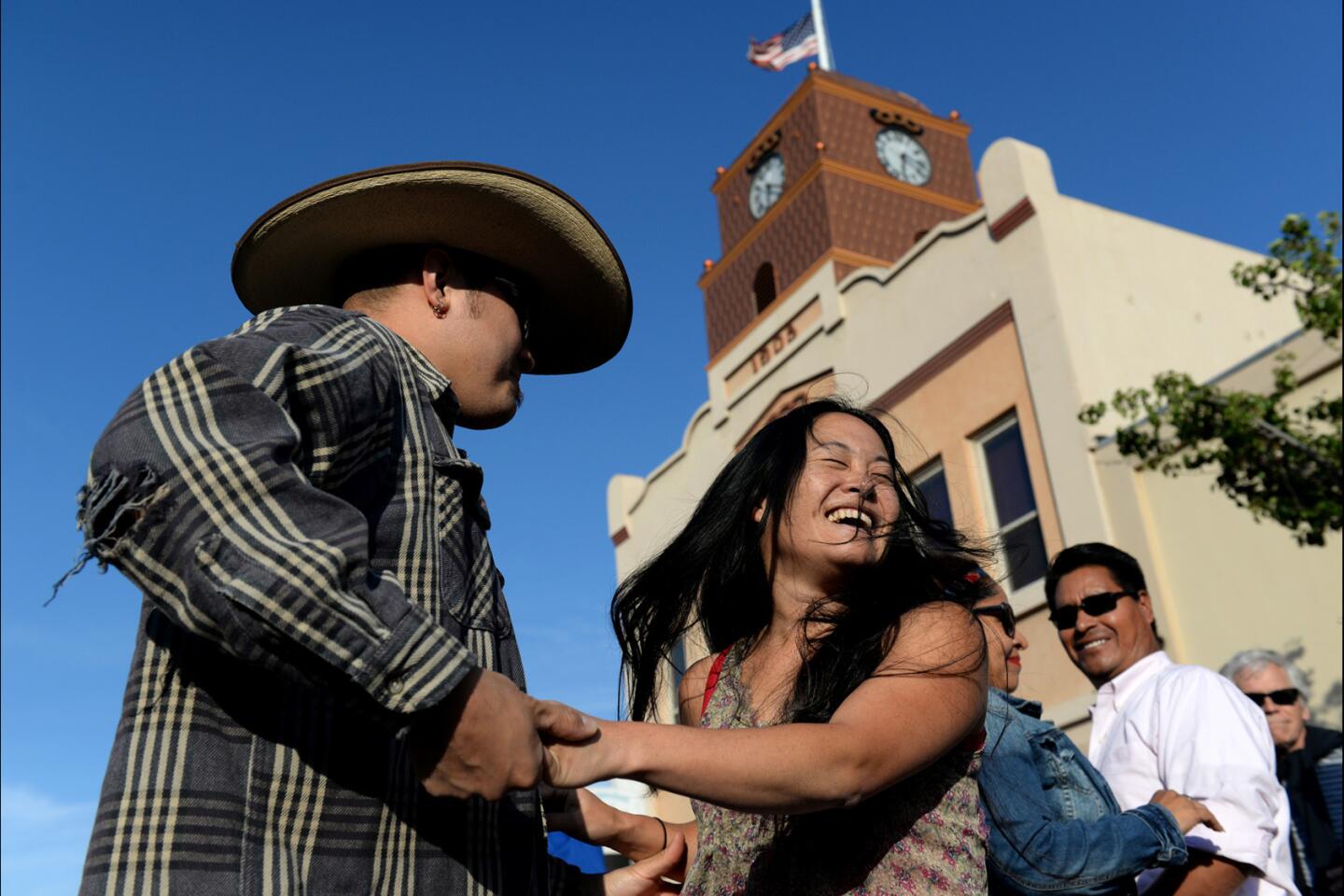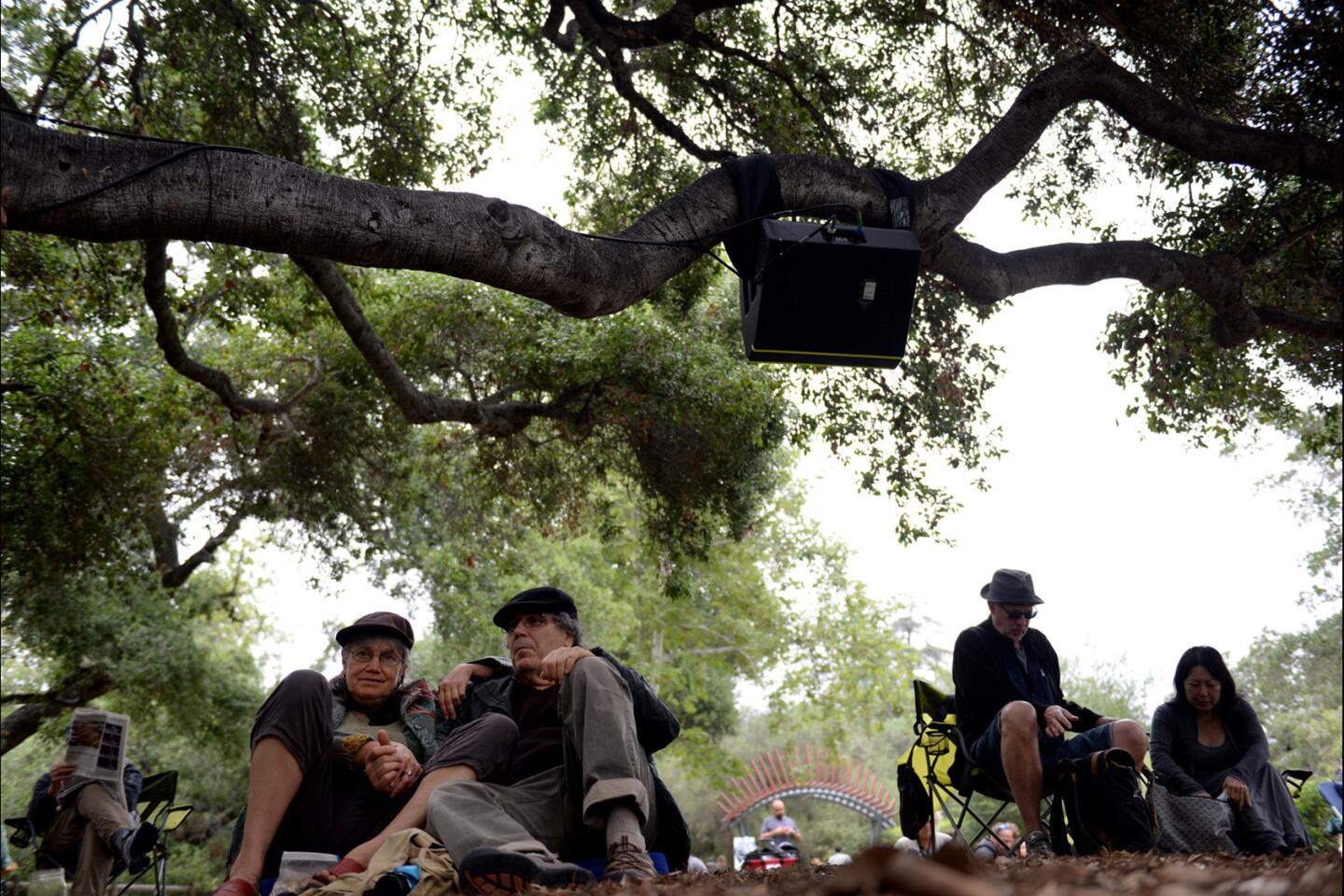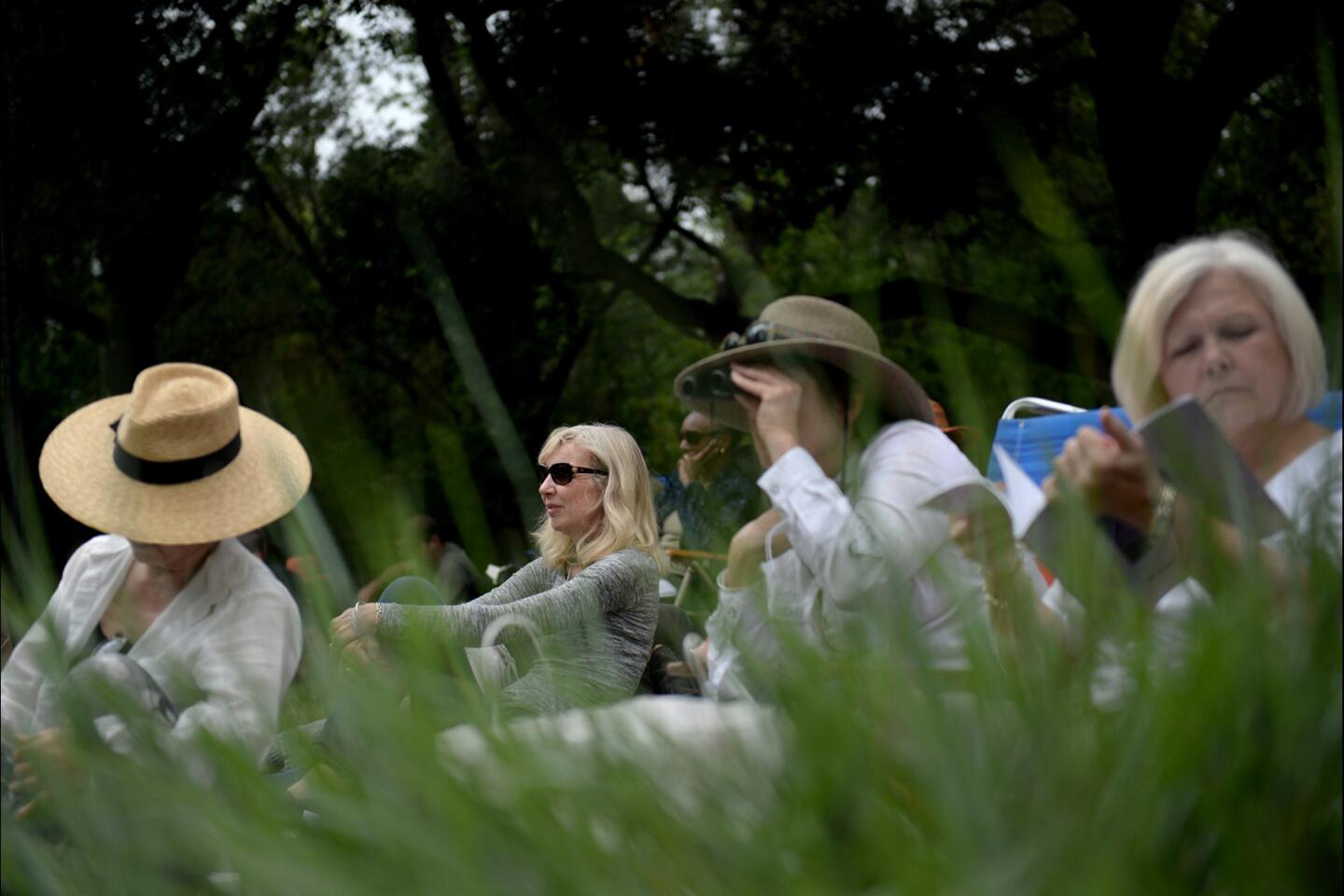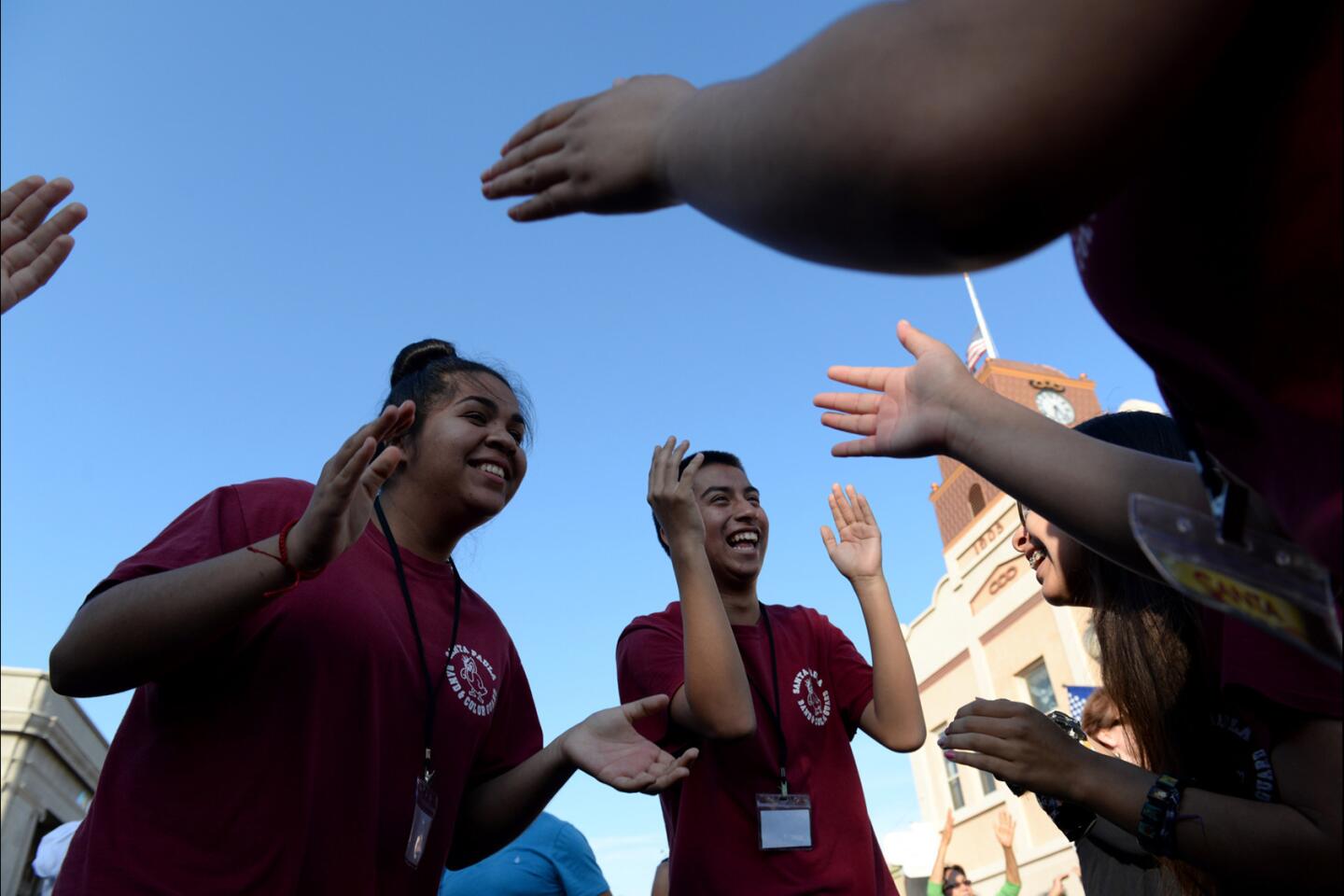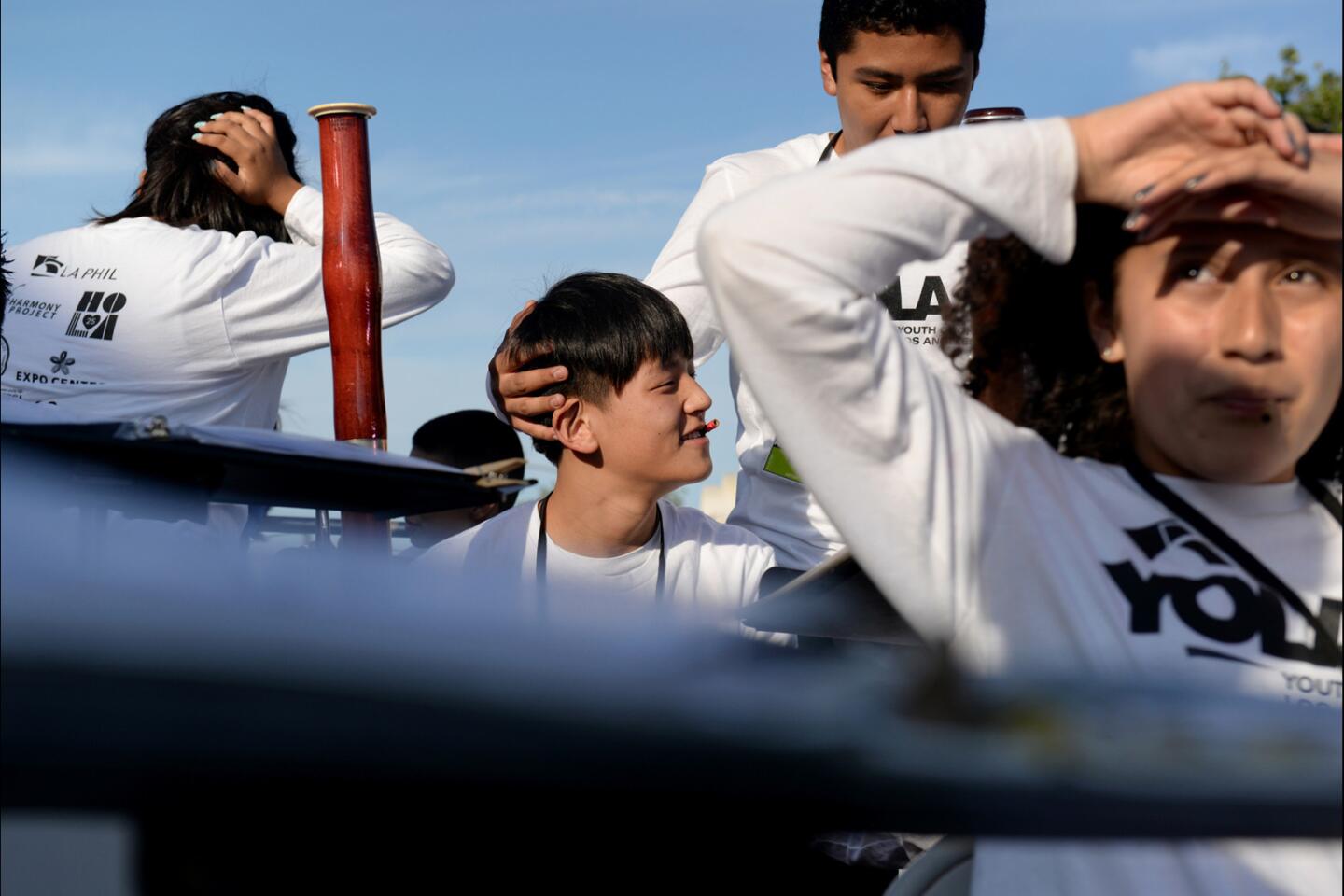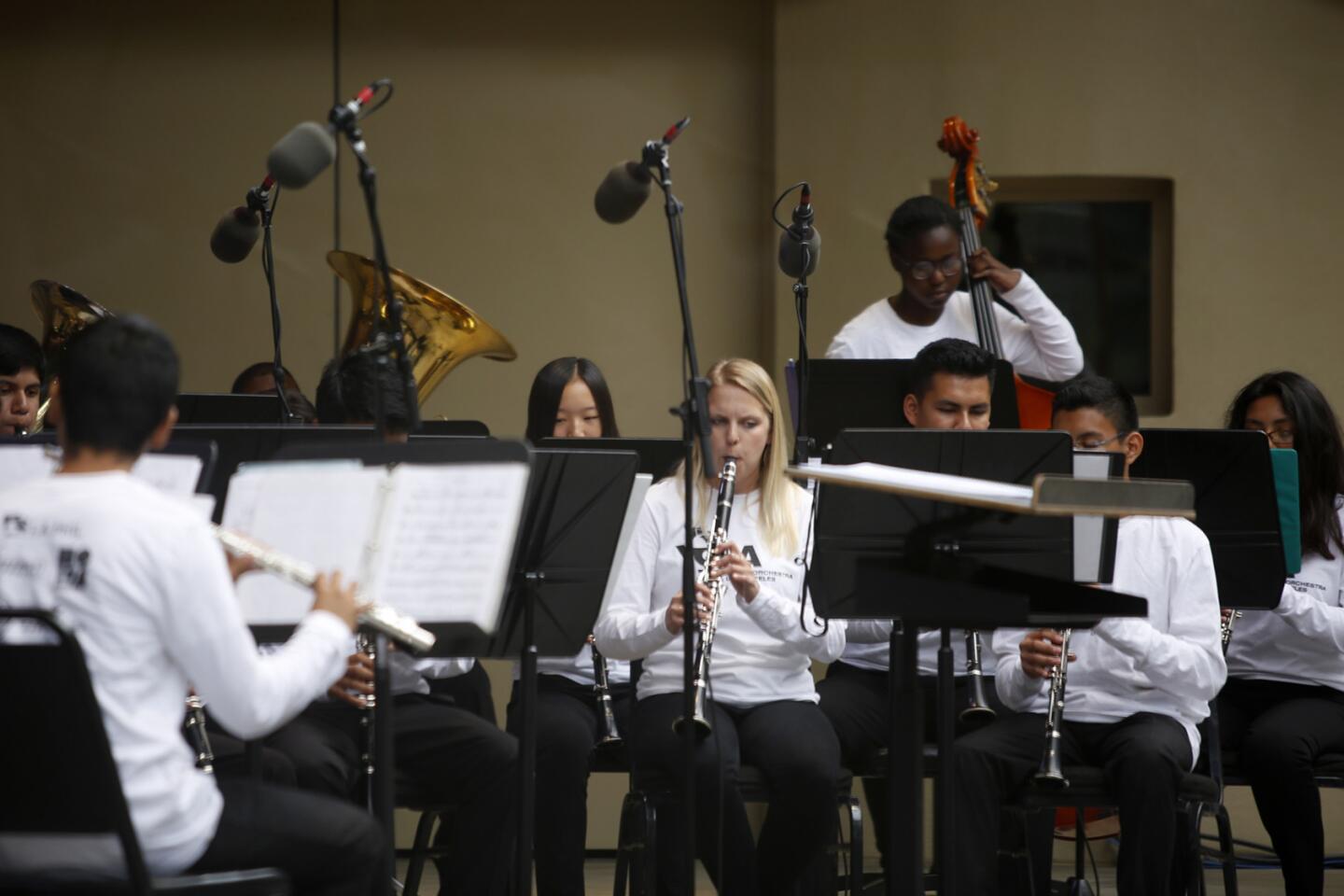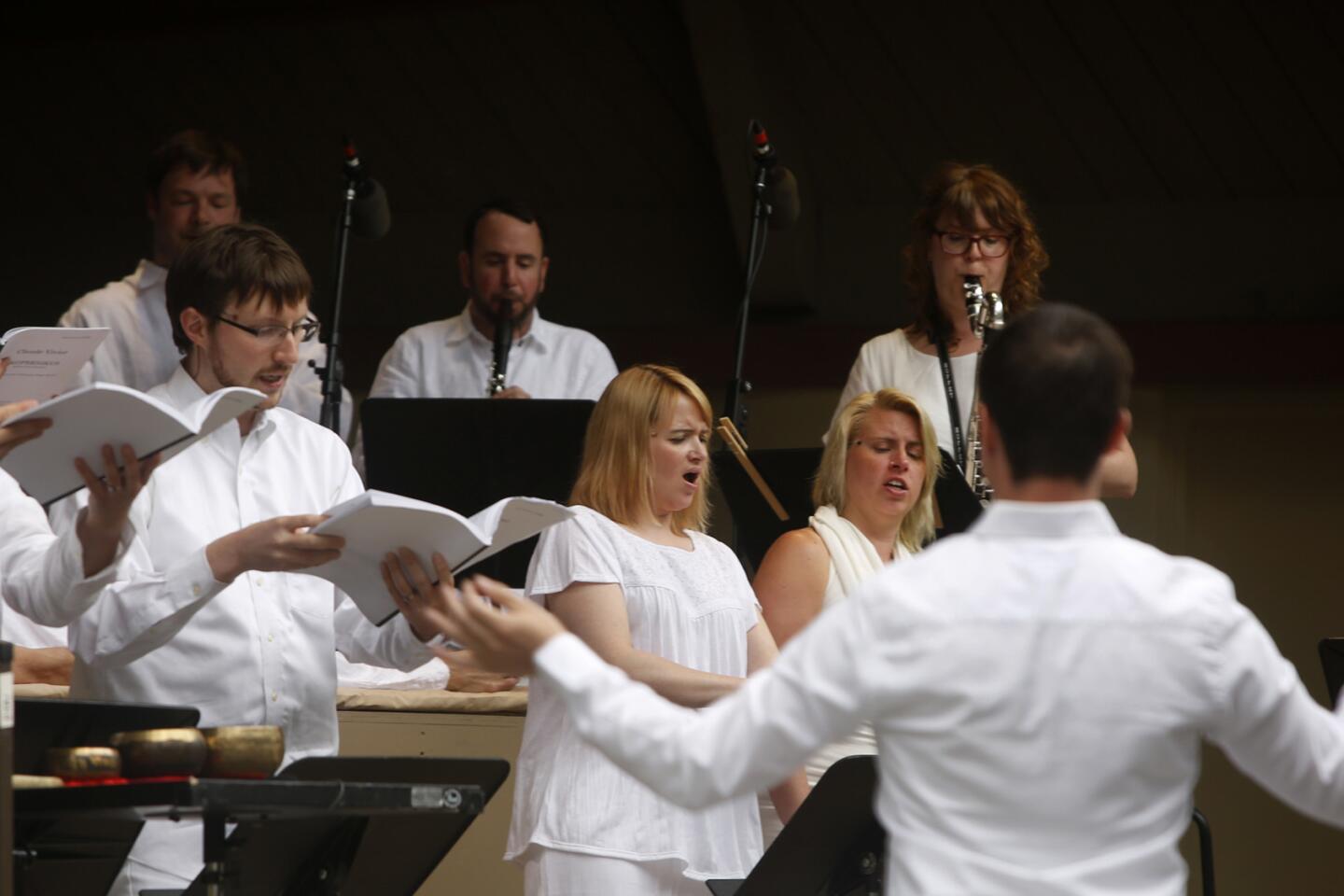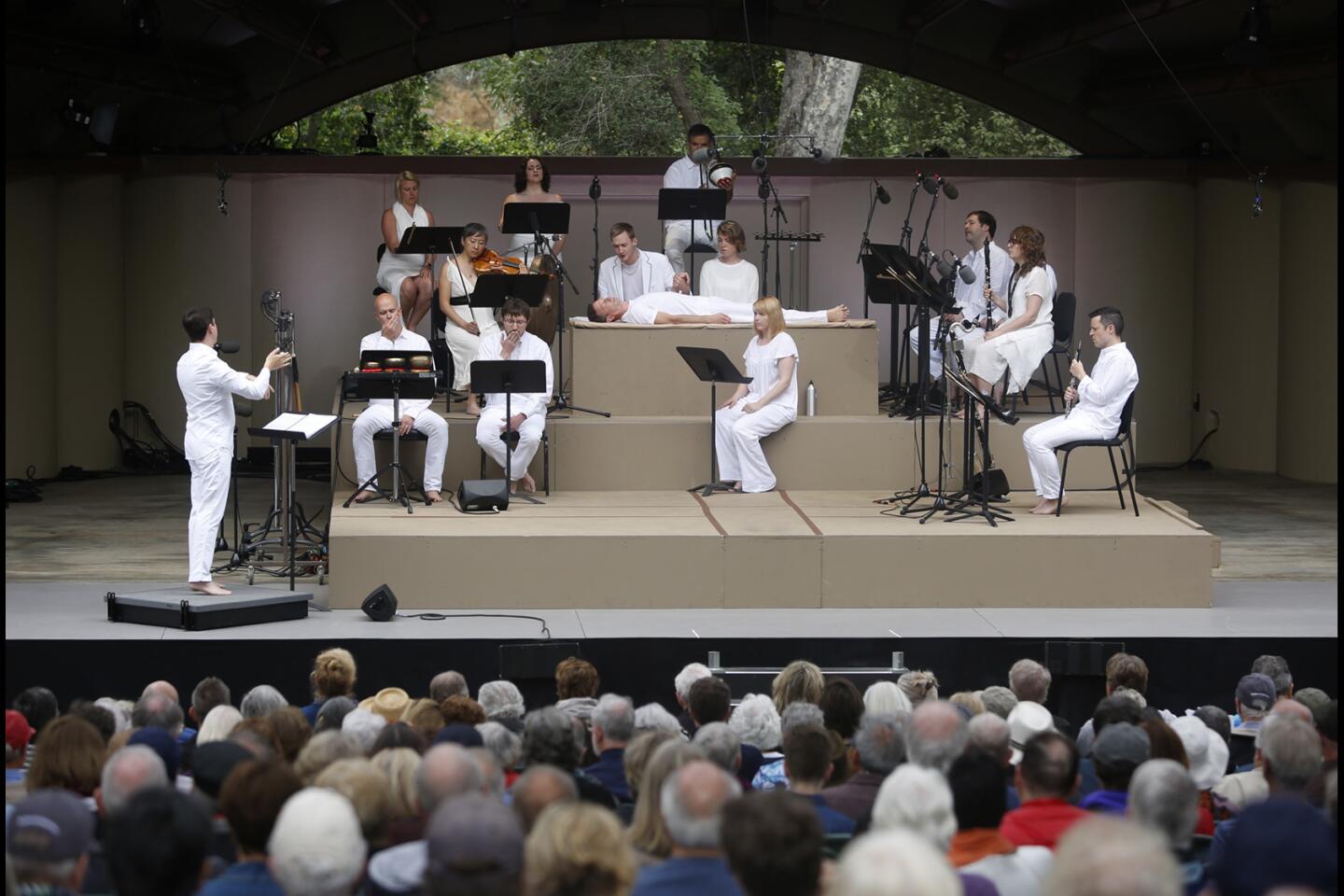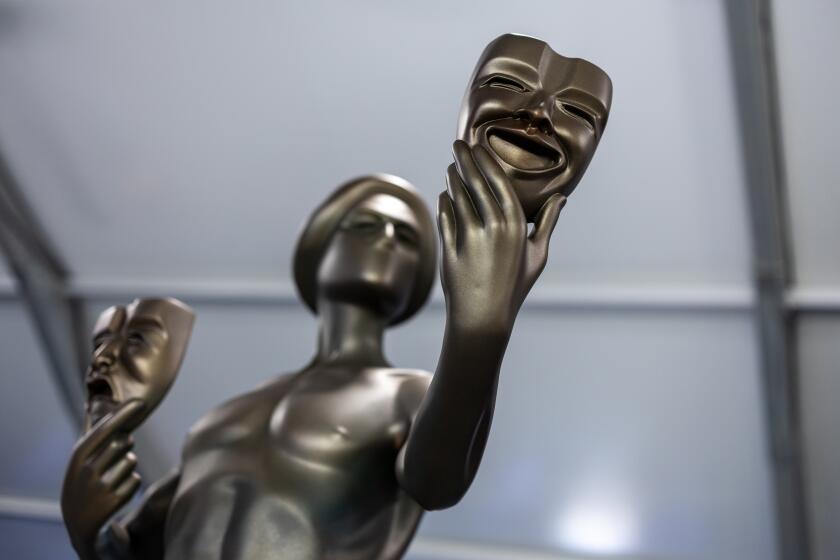Column: Worlds meet and worlds beyond at Ojai Music Festival
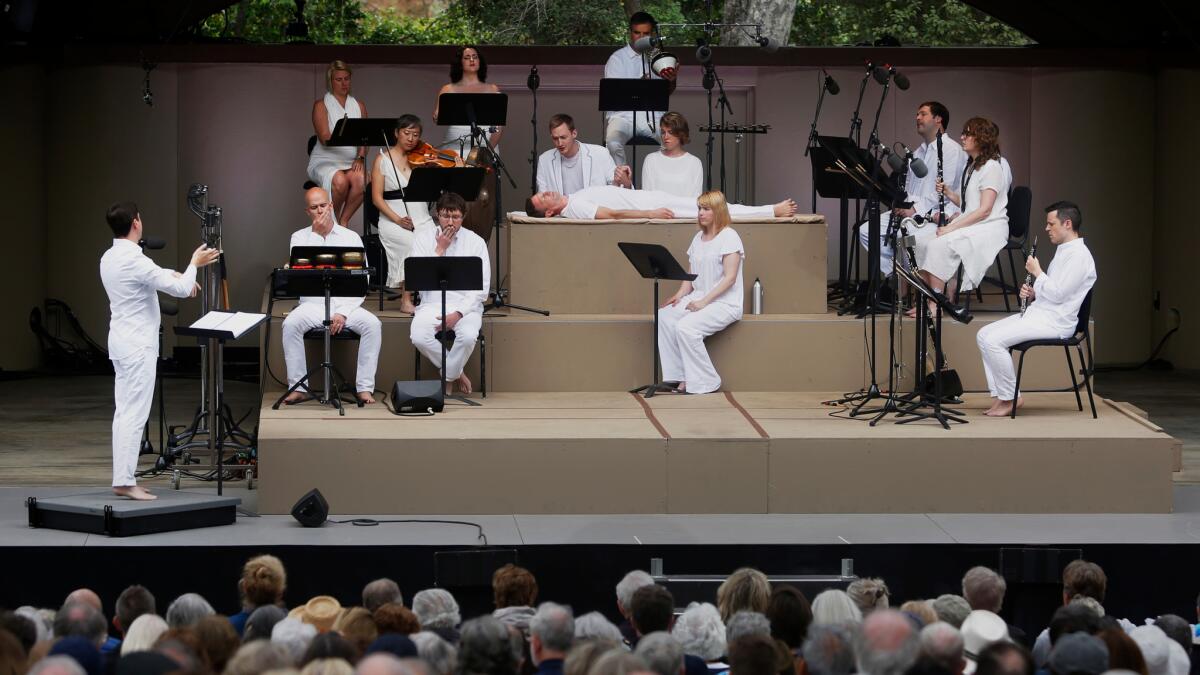
- Share via
Reporting from OJAI — As the great Southern California music retreat, the Ojai Music Festival offers venturesome refuge from normal life for locals and visitors to this blissed-out valley. But on the final day of the festival that had begun Thursday, we awoke to the same horrific news from Orlando as the rest of the country.
This year’s Ojai music director, Peter Sellars, led a moment of silence in Libbey Bowl at 3 p.m., the hour Florida Gov. Rick Scott had asked the nation to remember the 49 killed in the mass shooting in a gay nightclub. The silence here initiated the U.S. premiere of Claude Vivier’s ritual opera, “Kopernikus.” As staged by Sellars, this wondrously mystical masterpiece became a profound and uncanny guide for the dying as they leave this world and prepare for the transcendent next.
That “Kopernikus” happened to be written by a dazzlingly original young Canadian composer murdered by a gay prostitute in Paris in 1983 might have made the premiere of this too-little-known 1979 opera seem all the more uncanny. But for Sellars, the prime function of art is to serve as a spiritual early warning system.
The opera itself isn’t exactly obscure. Netherlands Opera produced it a dozen years ago, as did Opera Factory Freiburg more recently, and there are recordings of both. But the European approach has been to treat the 70-minute experimental opera as a Stockhausen-infused Postmodern circus.
Vivier’s libretto reads like a phantasmagoric dreamscape. A dying figure, Agni, is surrounded by the countenances of mythic beings, including Mozart, Lewis Carroll, a witch, the Queen of the Night, Copernicus, Tristan and Isolde. Seven singers become their voices on occasion, but mostly they sing Dada-esque nonsense syllables.
Oboe, three clarinets, trombone, violin and a trumpet (as a voice calling from the beyond) make up the instrumental ensemble, which is enhanced by electronics. There are recognizable musical formulas, and there is unrecognizable musical chaos, just as there are recognizable words and unrecognizable ones, recognizable singing styles and all kinds of weird vocal sounds.
For Sellars this is simply the Balinese ceremony for the dead, so for his ritualistic staging, instrumentalists and singers dressed in white were placed on a high stage over the body of dancer Michael Schumacher. He remained immobile for an hour (devastatingly so during the moment of silence), then rose to the call of the trumpet from behind the audience and began his journey. Allusions in word and music to this world, past and present and future, appeared to enter into his being. The effect was utterly transfixing.
The performers, conducted by Eric Dudley, were the respective instrumental and vocal New York ensembles ICE (International Contemporary Ensemble) and Roomful of Teeth. They softened the Modernist edge to Vivier’s score but replaced that with spiritual purpose. “Kopernikus” is an opera we need, and the encouraging news from Ojai is that Sellars plans to develop this production for international consumption.
The other Sellars-staged pieces were concerned with social responsibility, and both were solo vehicles for Julia Bullock, who had appeared in the 2011 festival as a student performer and is now on the verge of what promises to be an astounding career. In a new chamber version of Finnish composer Kaija Saariaho’s 2006 “La Passion de Simone” on Thursday night, Bullock transformed a somber meditation on the disturbing French philosopher and activist Simone Weil’s suicidal self-sacrifice into a ritual of a young African American woman finding her place in a protest movement.
In the long, late-night “Josephine Baker: A Portrait,” Bullock sang the famous African American’s Parisian show tunes as dark meditations and protest songs. Avant-garde percussionist and pianist Tyshawn Sorey recomposed everything for members of ICE. Poet Claudia Rankine added introductory texts that were rarely useful, but Bullock’s singing, dancing and sheer stage presence proved hauntingly effective.
The baritone, Davóne Tines, is the new name to remember from this festival. Discovered by Sellars as a phenomenal singer of spirituals, Tines was invited by Sellars to be in his production of Saariaho’s new opera, “Only the Sound Remains,” which was to have had its U.S. premiere at Ojai but had to be canceled because of its technical demands. Two brilliant afternoon chamber concerts of Saariaho’s chamber music did, however, remain. They concluded with her recent piece “Sombre,” a setting of three late Ezra Pound cantos — the poet conversing, like Vivier if in a more terrestrial way, with paradise.
“I have tried to write Paradise,” Pound writes. Tines doesn’t need to try. He is a singer of immense power and fervor. Everyone in Ojai was talking about him. Saariaho also had the benefit of performers — ICE, flutist Claire Chase, bass flute Camilla Hoitenga, the Calder Quartet and conductor Joana Carneiro — uncovering under her shimmering surfaces strong dramatic musical material.
See more of Entertainment’s top stories on Facebook >>
Much more of this festival was, Sellars style, all over the place — and the globe. Sellars imported the blowsy Egyptian singer Dina El Wedidi and her fusion band, as he did the alluring Carnatic Indian singer Aruna Sairam with her inspired traditional Indian musicians. These are paths that didn’t show any need to cross.
There were daily doses of Roomful of Teeth, which has become popular for its cute use of extended vocal techniques and because the alto Caroline Shaw is an appealing young star composer. The ensemble needs stretching, which “Kopernikus” is clearly doing.
The heavy stretching, though, was with YOLA at HOLA Symphonic Winds, the Los Angeles Philharmonic’s student group. For the free family Sunday afternoon concert that preceded “Kopernikus,” Tania León wrote and conducted “Pa’lante” for the kids and four ICE wind soloists who have been coaching them. They rocked Libbey Bowl. L.A. Phil teenage composer fellows Benjamin Champion, Robby Good, Luca Mendoza and Ethan Treiman provided solo pieces for the ICE winds; L.A. Phil senior composer fellows Sharon Hurvitz and Andrew Moses wrote wind quartets. All revealed spunky curiosity for cleverly unusual sounds and arresting theatricality.
Sellars’ most radical move was to end the festival with a free street party in downtown Santa Paula, a flamboyant celebration of life after Vivier’s flamboyant dance of death. The Latino band Los Jornaleros del Norte, YOLA, El Wedidi, Sairam and Tines took turns performing on two stages. By evening’s end the crowd thinned to a couple hundred festivalgoers and Santa Paula natives dancing to another Latino band, Cambalache, here two worlds meeting not in a refuge but on Main Street.
More to Read
The biggest entertainment stories
Get our big stories about Hollywood, film, television, music, arts, culture and more right in your inbox as soon as they publish.
You may occasionally receive promotional content from the Los Angeles Times.
